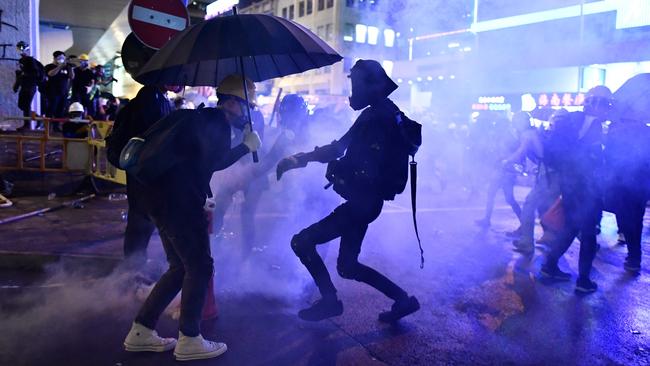HK protests becoming more violent
Teargas no longer seems shocking in Hong Kong’s Central district.

Fifty days on from the first huge marches, the territory’s nameless, leaderless protest movement is escalating.
Confronting relentless activism, the police have been criticised, yet again, for their heavy-handed tactics. The protesters, too, are becoming more violent. The city’s chief executive, Carrie Lam, has not shown herself in public for a week.
In Hong Kong, the weekend started peacefully enough.
On Friday, thousands of protesters camped out in the arrivals hall of the airport to alert visitors to their cause. Tensions were rising over a march planned for the next day to protest against violence the previous week at a train station in Yuen Long, a new town in the rural part of the New Territories, a part of Hong Kong on the mainland. Dozens of men in white T-shirts had attacked members of the public with sticks and rods. They were widely believed to be members of criminal gangs, the triads.
Citing security issues, the police refused to allow the protest, but on Saturday tens of thousands of people made their way to Yuen Long anyway. Some shared tips on how to pretend they were not going to a political rally. On the day, there was no doubting their intentions. Most protesters have by now stopped complaining about the proposed legislation, allowing extradition to China, which sparked the first, mammoth demonstrations in early June. This time their targets were both the gangs blamed for the thuggery at Yuen Long and the entire establishment — above all, the police, local politicians and the Chinese government— and its refusal to allow Hong Kong to elect its own leaders.
In previous weeks, the large numbers of people and a peaceful march have helped calm tempers. This time protesters were antagonistic from the outset.
Many came kitted-up with masks, goggles and hats to protect against teargas and pepper spray. Some pulled up railings to use as barricades and bricks to use as weapons. Protesters denied coming to Yuen Long to pick a fight with the villagers but insisted that if triad members turned up, they were ready. For the first time, many carried hiking poles to defend themselves. At least two cars were vandalised by protesters who claimed they contained weapons that linked the owners to the Chinese government.
The police formed cordons around villages close to the station. These became the frontlines between protesters and the police. As the sky turned purple in the sunset, a command circulated through the crowd urging protesters to “leave together” at 7.30pm. Many heeded the call, and were able to reach the train station, where the barriers were left open and special trains put on.
If the protesters behaved better than many had feared, the police did not. At 10pm, police cleared the station with a liberal use of batons. Hospitals reported that 24 people were being treated, two for serious injuries. Amnesty International denounced “repeated instances where police officers were the aggressors; beating retreating protesters, attacking civilians in the train station and targeting journalists.”
The scenes at the station did little to calm nerves in the city. On Sunday, police were back on the streets again after protesters who had turned up for an authorised rally in a park on Hong Kong Island promptly spread out, blocking roads and forming multiple frontlines to face the police. Some protesters headed west and tried to return to the government’s offices in Sheung Wan; others went east towards Wan Chai police station and Causeway Bay, a big shopping area.
As they did a week earlier, police swept slowly through, trying to disperse the crowds. To slow them down, protesters for the first time lit fires in the street.
Locals and tourists took the chaos in their stride. Couples enjoying pizza in a roadside restaurant had a front-row seat as a tear-gas canister exploded outside. Later, fleeing protesters got a thumbs-up from an old lady in the stairwell of her apartment building. Others, forced to walk home, had their eyes, stinging from teargas, washed by members of the public.
The government appears to have no idea how to bring the situation under control. Lam spent Saturday afternoon hobnobbing with bigwigs from China, including the head of its Hong Kong liaison office, at a summer camp organised by the People’s Liberation Army, which has been garrisoned in Hong Kong ever since the handover of sovereignty from Britain to China in 1997.
Yesterday, on the orders of the central government, the Hong Kong and Chinese flags above government offices flew at half mask in mourning for Li Peng, a former Chinese premier who died last Monday. He is known as “the butcher of Beijing” for ordering troops to use lethal force to end the Tiananmen Square protests in Beijing in 1989. It no longer seems inconceivable to Hong Kongers that the same army might also be brought in to clear their streets.



Teargas no longer seems shocking in Hong Kong’s Central district.